
|
How-To Speech Ideas, Requirements, and Models
It is appropriate to teach some public speaking skills to ESL students in addition to conversation practice. The easiest first speech is a how-to speech since it is usually relatively short and uses visual aids that help keep the speaker focused and give the audience something to stare at besides the speaker. In this file there are a list of many...
Level: intermediate
Age: 12-100
Type: activity-card
Downloads: 10
|
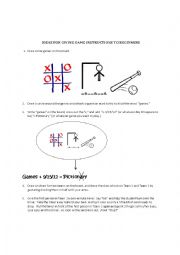
|
Ideas for Giving Game Instructions to Beginners
How do you get beginners to do or understand anything? You must mime and draw and emote. But most teachers, especially new teachers, talk a lot, and too often all that the students hear is a very frustrating, "Blah, blah, blah." Here�s an example of how to get very low beginners to understand the vocabulary term "game" and actually play a game--Pic...
Level: elementary
Age: 3-100
Type: article
Downloads: 23
|

|
Idiom Origins Reading with Review Exercise
A shocking and humorous explanation of how some common idioms came about. I suggest passing around one copy and having twelve students read one paragraph each aloud. The exercise that accompanies the reading can then offer a way to check how well the students listened and understood the article. After the students have completed the exercise, pas...
Level: intermediate
Age: 10-100
Type: reading
Downloads: 27
|

|
Idioms Literal and Figurative Meanings Matching Game
When students first hear an idiom, they may try to picture what the words literally say. But idioms are figurative expressions that do not mean what the students might suspect. When teaching idioms, it can, therefore, be quite instructive to have students draw two simple drawings for each idiom. First, they should draw what the words literally ...
Level: intermediate
Age: 12-100
Type: activity-card
Downloads: 22
|
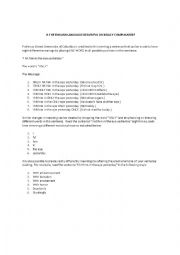
|
Intonation Practice
A handout to walk students through making recordings that help them understand how stress and emotion can change the meaning of a sentence.
Level: intermediate
Age: 10-100
Type: worksheet
Downloads: 5
|
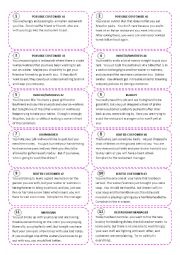
|
Restaurant Roleplay Cards
12 roleplay cards for issues that could arise related to restaurants, plus a map of where to place students for the roleplays. Give all the students their cards privately and circulate to answer any questions. Students should not show their cards to each other. Then have the students outside the restaurant start the roleplay. Once they have been...
Level: intermediate
Age: 18-100
Type: activity-card
Downloads: 92
|
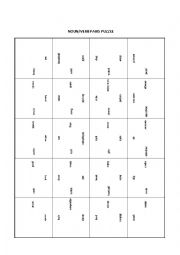
|
Square Puzzles for Noun/Verb Pairs and Idioms and Their Definitions
Print and cut apart one of each puzzle for every 2-3 students. Start the students with the noun/verb puzzle to get the students used to how this type of puzzle works. Suggest they work with the corner and edge pieces first like many of us tackle jigsaw puzzles. Circulate around the classroom a lot, especially with the first puzzle they do to make...
Level: intermediate
Age: 8-100
Type: activity-card
Downloads: 8
|
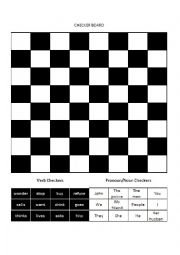
|
Subject/Verb Agreement Checkers
Grammar meets checkers. The students can only jump opponents� checkers if there is subject/verb agreement between the pieces involved in the jump. For example, a checker with "he" on it can jump a checker with "writes" on it, but not a checker with "write" on it. Students will have to pay close attention to any s�s they see.
Level: elementary
Age: 5-100
Type: activity-card
Downloads: 25
|
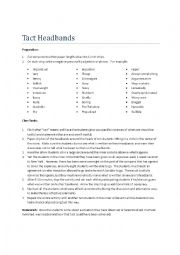
|
Tact Headbands
Students roleplay a situation while wearing headbands that identify negative character traits. The other roleplayers must use tact while speaking about the character traits, and everyone tries to guess what their headbands said at the end of the activity.
Level: intermediate
Age: 12-100
Type: activity-card
Downloads: 6
|
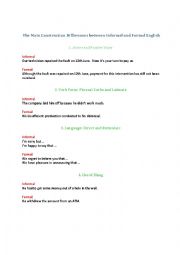
|
The Main Construction Differences between Informal and Formal English
Explanations and examples of the nine main differences between informal and formal English.
Level: intermediate
Age: 16-100
Type: grammar-guide
Downloads: 13
|